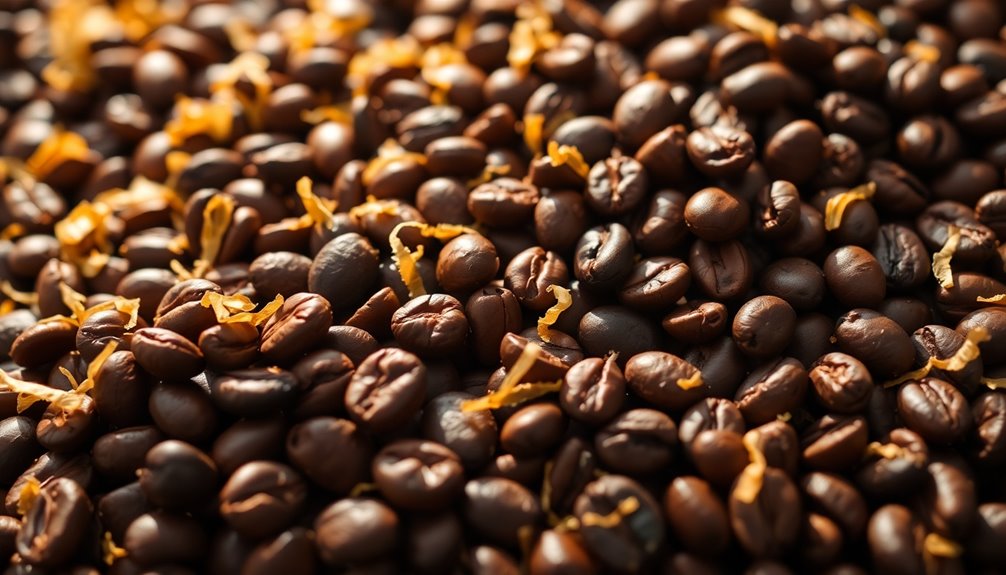Transforming coffee waste into value offers exciting opportunities. By repurposing coffee grounds, you can produce biofuels like biodiesel and biogas, turning waste into renewable energy sources. These practices help reduce landfill trash and methane emissions while supporting a circular economy. Coffee grounds can also be used in organic fertilizers, skincare, and biodegradable packaging. Keep exploring to discover how innovative methods are expanding coffee waste’s potential as an eco-friendly resource.
Key Takeaways
- Coffee grounds contain organic compounds suitable for conversion into biofuels like biodiesel and biogas.
- Recycling coffee waste reduces landfill contributions and methane emissions, supporting environmental sustainability.
- Coffee grounds can be repurposed into renewable energy sources, promoting a circular economy.
- Beyond biofuels, coffee waste serves as a natural fertilizer, biodegradable packaging, and skincare ingredient.
- Implementing waste valorization strategies enhances resource efficiency and innovation in the coffee industry.

Every year, millions of tons of coffee waste are discarded worldwide, yet this overlooked byproduct holds untapped potential. Coffee grounds, often tossed aside after brewing, can be transformed into valuable resources that benefit the environment and economy. To access this potential, adopting sustainable harvesting practices is essential. Sustainable harvesting ensures that coffee beans are collected efficiently without damaging the surrounding ecosystem, which in turn minimizes waste at the source. When farmers and producers prioritize eco-friendly methods, they reduce overharvesting and waste generation, creating a more balanced supply chain. This approach not only conserves natural resources but also paves the way for effective waste reduction strategies, making the most out of every part of the coffee plant.
Waste reduction strategies play a vital role in addressing the global coffee waste problem. Instead of viewing used grounds as garbage, you can see them as a resource with multiple uses. For instance, coffee grounds can be repurposed into biofuels, offering a renewable energy source that reduces reliance on fossil fuels. The organic content in the grounds makes them ideal for conversion into biodiesel or biogas, which can power homes or industrial processes. By implementing these strategies, you help lower the volume of waste sent to landfills, cutting down on methane emissions and environmental pollution. Furthermore, reusing coffee waste through composting or as animal feed adds further value, closing the loop in sustainable waste management. Incorporating innovative uses of coffee grounds can further expand their utility and impact.
On a practical level, waste reduction strategies involve sorting, processing, and innovating with coffee grounds to create new products. Coffee grounds are rich in antioxidants, minerals, and organic compounds, making them suitable for a variety of applications beyond biofuels. They can be incorporated into biodegradable packaging, natural fertilizers, or skincare products, reducing the need for synthetic alternatives. When you embrace sustainable harvesting and waste reduction strategies, you’re actively participating in a circular economy—maximizing the utility of coffee byproducts and minimizing environmental impact. This integrated approach not only conserves resources but also fosters innovation within the coffee industry, encouraging producers and consumers alike to rethink how waste is perceived and utilized.
Frequently Asked Questions
Can Coffee Waste Be Used to Produce Biodegradable Plastics?
Yes, coffee waste can be used to produce biodegradable plastics. You can turn coffee grounds into valuable Coffee waste applications, such as bioplastics, by extracting compounds like cellulose and lignin. These materials serve as raw ingredients for creating eco-friendly, biodegradable plastics, reducing environmental impact. This innovative approach helps you repurpose coffee waste sustainably, promoting greener alternatives to traditional plastics and advancing the circular economy.
What Are the Environmental Impacts of Converting Coffee Grounds Into Biofuels?
Converting coffee grounds into biofuels reduces pollution and lowers your carbon footprint, but it also brings environmental challenges. While it diminishes waste and fossil fuel reliance, it can cause habitat disruption and chemical runoff if improperly managed. You must weigh the benefits of pollution reduction against potential ecological impacts, ensuring sustainable practices that minimize harm and maximize eco-friendly benefits. This balance is essential for truly positive environmental outcomes.
How Cost-Effective Is Converting Coffee Waste Into Energy Sources?
Converting coffee waste into energy can be cost-effective if you consider the economic feasibility, but scalability challenges remain. You might find it promising for small-scale applications or local use, but expanding this process involves significant investment and infrastructure. While it offers a sustainable solution, you’ll need to weigh the costs against potential environmental benefits and market demand to determine if it’s truly viable for your specific needs.
Are There Any Health Risks Associated With Using Coffee Grounds as Biofuel?
You should be aware that using coffee grounds as biofuel does carry some health risks. Contamination concerns arise if the grounds contain impurities or residues, which could introduce toxins. Inhalation hazards are also possible if you’re handling or burning the grounds without proper ventilation or protective gear. To stay safe, confirm the grounds are clean and handle them in well-ventilated areas, minimizing exposure to potential contaminants and inhalation risks.
What Are Innovative Applications of Coffee Waste Beyond Biofuels?
You can turn coffee waste into innovative applications like coffee ground pharmaceuticals, where compounds boost skin healing and reduce inflammation. You might also explore coffee waste textiles, creating sustainable fabrics for clothing and accessories. Imagine repurposing grounds into eco-friendly products that benefit health and fashion alike, transforming everyday waste into valuable resources. This dual approach not only reduces environmental impact but also opens new markets for coffee byproducts.
Conclusion
Now that you know how coffee grounds can be transformed into biofuels and other valuable products, it’s clear you’re sitting on a goldmine of opportunity. Don’t let this chance slip through your fingers—turning waste into wealth is a win-win for the planet and your pocket. By harnessing innovative solutions, you’re helping to reduce environmental impact while creating new possibilities. Remember, where there’s a will, there’s a way to turn coffee waste into something extraordinary.









